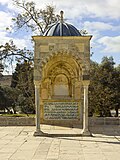โดมยูซุฟ
โดมยูซุฟ (อาหรับ: قبة يوسف) เป็นโครงสร้างโดมเดี่ยวบนเนินพระวิหาร ตั้งอยู่ทางใต้ของโดมแห่งศิลา
โดมนี้สร้างโดยเศาะลาฮุดดีน (พระนามตอนพระราชสมภพ ยูซุฟ) ในคริสต์ศตวรรษที่ 12 และได้รับการบูรณะหลายครั้ง[1][2][3] โดยมีจารึกในคริสต์ศตวรรษที่ 12 และ 17: อันที่สลักใน ค.ศ. 1191 พร้อมพระนามของเศาะลาฮุดดีน และอีกสองอันที่กล่าวถึงยูซุฟ อะฆอ ซึ่งน่าจะเป็นผู้ว่าการเยรูซาเลมหรือขันทีในราชสำนักออตโตมัน[1][4][5]
รายละเอียด[แก้]
โดมยูซุฟมีโครงสร้างกึ่งปิดสี่เหลี่ยมคล้ายกับซุ้มบูชา[6] โดยตั้งอยู่บนกำแพงหินแข็งและมีซุ้มโค้งเปิดแหลมสามอันรองรับ ทางด้านเหนือของกำแพงด้านทิศใต้มีหินแกะสลักและช่องม่าน (blind niche) หน้าหินอ่อน ด้านนอกโดมหุ้มด้วยแผ่นตะกั่ว และด้านในตกแต่งด้วยลายโครง[4][5]
โครงสร้างนี้มีจารึก 3 แห่ง:
- จารึกเด่นที่แผงด้านล่างที่เขียนด้วยข้อความภาษาอาหรับแบบนัสค์สีเขียวเมื่อ ค.ศ. 1191 (สมัยราชวงศ์อัยยูบิด) โดยเรียกเศาะลาฮุดดีนตามกุนยะฮ์ว่า อะบูลมุซ็อฟฟัร ("บิดาแห่งชัยชนะ") และพระนามส่วนพระองค์ ยูซุฟ[N 1] และยังกล่าวถึงเอมีร์ al-Asfahasalar Sayf ad-Din Ali bin Ahmad (al-Asfahsalar Ali bin Ahmad al-Hikkari) ที่ควบคุมดูแลการก่อสร้างสนามเพลาะป้องกัน[7]
- คำจารึกเล็ก ๆ ที่ไม่ได้ทาสีสองอันอยู่บน พื้นที่ช่วงโค้งของด้านหน้า (เหนือซุ้มโค้ง) ทั้งสองเขียนด้วยภาษาที่ต่างกัน แต่มีใจความเดียวกัน โดยสิ้นสุดด้วยเลข "1092" ในตัวเลขอาหรับตะวันออก (١٠٩٢) ซึ่งคือปีฮิจเราะห์ศักราชที่ทับซ้อนกับ ค.ศ. 1682 เพียงส่วนหนึ่ง[8]
แผงกลางสีขาวภายในช่องว่างเปล่า
อ้างอิง[แก้]
- ↑ อะบูลมุซ็อฟฟัร ยูซุฟ อิบน์ อัยยูบ (أبو المظفر يوسف بن أيوب) พระนามของเศาะลาฮุดดีน อยู่ในแถวที่สี่ เริ่มจากตรงกลาง
- ↑
จารึกฝั่งขวา (ตะวันตก):[8]
- "The superintendent Ali Agha has built this – that the reward should all fall on Yusuf Agha. On seeing it, the Oracle Hatif pronounced its date: Muharram of the year 1092 (AH)."
- ในข้อความภาษาตุรกีออตโตมัน:
- ปริวรรต: Yapdı Nazır Ali Ağa bunu / Ol ecri Yusuf Ağayı tamam / Dedi Hatif Kurnaci tarihin / Oldu bin doksanikide tamam / Muharrem sene 1092.
- ↑
จารึกด้านซ้าย (ตะวันออก):[8]
- "This [dome] has been built out of piety on behalf of Yusuf, / the agha of the Abode of Supreme Felicity [Istanbul], through his perfect piety. / We are presented with it in the phrasing (chronogram) regarding its construction. / Ali has built it [the dome], but the reward for it returns to Yusuf. / Muharram of the year 1092 (AH)."
- ในข้อความภาษาอาหรับ:
- ↑ 1.0 1.1 Carole Hillenbrand (2000). The Crusades: Islamic perspectives (Illustrated, reprint, annotated ed.). Routledge. p. 191. ISBN 978-0-415-92914-1.
a monumental inscription dated 587(AH)/1191 in [Saladin's] name on the Dome of Joseph [Qubbat Yusuf] on the Haram esplanade: 'the victorious king, the probity of this world and of [true] religion, the Sultan of Islam and of the Muslims, the servant of the two noble sanctuaries and of Jerusalem.'
- ↑ Necipoğlu, Gülru (1998). Muqarnas: An Annual on the Visual Culture of the Islamic World (Illustrated, annotated ed.). BRILL. p. 73. ISBN 978-90-04-11084-7.
- ↑ Myriam Rosen-Ayalon (2006). Islamic art and archaeology in Palestine (Illustrated ed.). Left Coast Press. p. 97. ISBN 978-1-59874-064-6.
- ↑ 4.0 4.1 [ลิงก์เสีย] Qubbat Yusuf เก็บถาวร สิงหาคม 5, 2011 ที่ เวย์แบ็กแมชชีน Archnet Digital Library.
- ↑ 5.0 5.1 [ลิงก์เสีย] Al-Aqsa Guide Friends of al-Aqsa 2007. เก็บถาวร ธันวาคม 20, 2008 ที่ เวย์แบ็กแมชชีน
- ↑ Hillenbrand, Robert (2000). Auld, Sylvia (บ.ก.). Ottoman Jerusalem. London: British School of Archaeology in Jerusalem. p. 16. ISBN 978-1-901435-03-0.
[…] two structures erected by Yusuf Agha in 1681 – the Qubbat Yusuf (an open-plan aedicule) and the Qubbat Yusuf Agha (a closed domed square) – clearly suggest that, despite the identical terminology, different forms connoted different functions in Jerusalem at that time.
- ↑ "Marble inscription panel". Museum with No Frontiers.
- ↑ 8.0 8.1 8.2 Tutuncu, Mehmet (2006). Turkish Jerusalem (1516-1917): Ottoman Inscriptions from Jerusalem. SOTA.
The name Qubbat Yusuf refers not only to the builder Yusuf Agha but it also refers to Salahaddin. He is referred to in the inscription as Abulmuzaffer Yusuf.
A version is here, p. 10-12, but it misspells "piety" (should be التقوى) as التققى.
31°46′38.60″N 35°14′07.17″E / 31.7773889°N 35.2353250°E
แหล่งข้อมูลอื่น[แก้]
 วิกิมีเดียคอมมอนส์มีสื่อเกี่ยวกับ Dome of Yusuf
วิกิมีเดียคอมมอนส์มีสื่อเกี่ยวกับ Dome of Yusuf- 360-degree view from under the dome
- A 19th-century map of the area. It is labelled lowercase n. The author, Ermete Pierotti, claims it was where Saladin prayed after winning the Siege of Jerusalem: "où Saladin fit sa premiere prière après la prise de Jérusalem".


